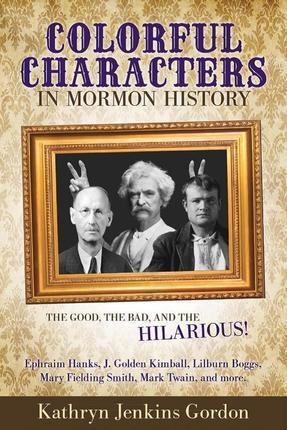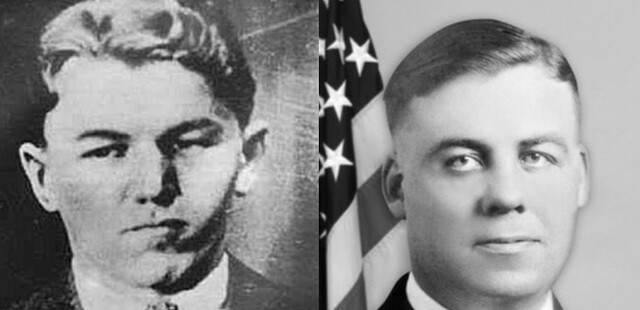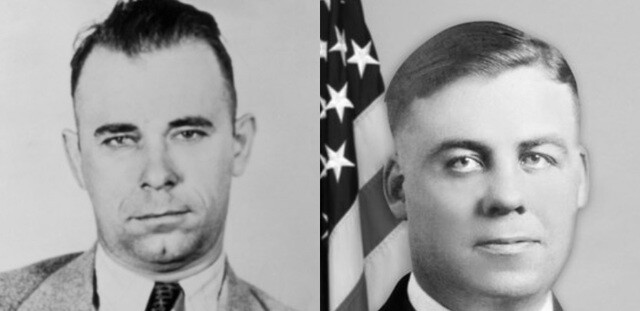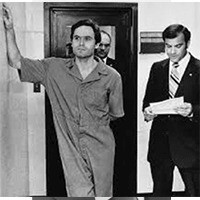With the release of a recent Netflix documentary and a 2019 Sundance film centered around Ted Bundy, this notorious serial killer has been in the media a lot lately. But it's important to note the heroes who helped bring this man to justice, including a Latter-day Saint highway Patrol Trooper, Robert Hayward. Learn more about Hayward and FBI agent Sam Cowley, two Latter-day Saints who helped bring three of the most notorious criminals to justice.
Here's how they did it:
1. Robert Hayward—Ted Bundy
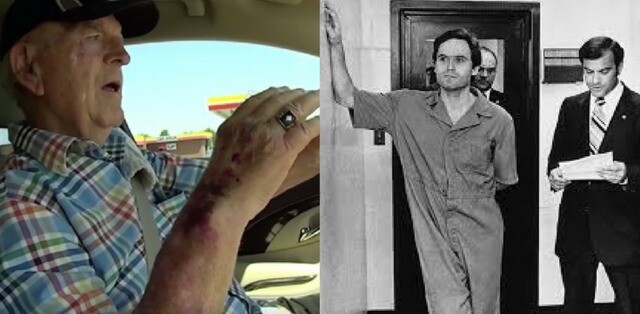
Images from YouTube and people.com. Left: Robert Hayward Right: Ted Bundy
A wrong turn. That's what led Utah Highway Patrol Trooper Robert Hayward to arrest Ted Bundy, a serial killer and rapist, and save the lives of Bundy's next would-be victims—teenage girls left alone in their home while their parents were on vacation.
Hayward was just finishing up paperwork inside his patrol car at around 3 a.m. on August 16, 1975, when he saw a tan Volkswagon drive by, according to an article from The Salt Lake Tribune. A few minutes later, Hayward heard a call for help over his police radio.
While responding to the call, Hayward made a wrong turn and ended up in front of his neighbor's house—with the tan Volkswagon now in the driveway. Hayward followed the Volkswagon as it took off to an abandoned gas station. At gunpoint, Hayward questioned the driver of the car, who initially told Hayward he had gotten lost after watching Towering Inferno at a drive-in, but Hayward knew that movie wasn't playing.
After searching Bundy's car, Hayward found pantyhose, a crowbar, a ski mask, an ice pick, and handcuffs. Hayward booked Bundy into the Salt Lake County Jail. From there, the Salt Lake County sheriff's investigators took over the case.
On March 1, 1976, Bundy was convicted of the kidnapping and assault of Carol DaRonch in Salt Lake City and sentenced to 15 years in prison. But soon Bundy became the suspect in a growing number of homicides spanning several states. While facing murder charges in Colorado, Bundy escaped custody twice before making his way to Florida and continuing his spree of murder, assault, and rape. On February 15, 1978, Bundy was once again apprehended and convicted of murder. Before he was executed in Florida in 1989, Bundy confessed to committing 30 homicides in seven states.
Had Hayward not made a wrong turn that night, it's quite possible Bundy could have evaded police for quite some time.
"I often wonder if the Lord sent me in that direction," Hayward told the Associated Press about the night he apprehended Bundy. "If I didn't get him that night and stop him, I don't know how many more he would have got."
► You'll also like: "I Often Wonder If the Lord Sent Me in That Direction": LDS Highway Patrol Trooper Who Arrested Ted Bundy Dies at 90
2. Sam Cowley—John Dillinger
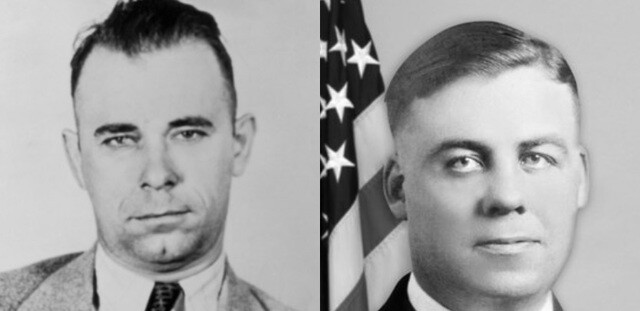
Images from bio.com and fbi.gov Left: John Dillinger Right: Sam Cowley
Sam Crowley wasn't supposed to become an FBI agent, let alone a national hero. No, Cowley was supposed to be an attorney, but when he entered the workforce on the same day the stock market crashed on October 24, 1929, he had to look outside the box for a job.
Instead, Cowley ended up in Washington D.C. working with the Federal Bureau of Investigation. Moving quickly through the ranks, Cowley was promoted to the rank of inspector after only five years at the bureau.
His work eventually led FBI Director J. Edgar Hoover, to approach Cowley with a request: find the infamous gangster John Dillinger.
Dillinger was a notorious bank robber, gang leader, and murderer during the Great Depression era. From September 1933 until July 1934, Dillinger and his gang murdered 10 men, staged three prison breaks, and robbed multiple banks and police arsenals.
Dillinger had eluded police and FBI agents during his crime sprees, so Hoover asked Cowley, with his promising career as an FBI inspector, to find this man.
But Cowley went a step further. Not only did Cowley locate Dillinger, he also organized a plan to capture the notorious gangster. On July 22, 1934, Dillinger entered the Biograph Theater for a showing of Manhattan Melodrama; he had no idea Cowley had stationed FBI agents at all the exits. As Dillinger was leaving, he began to notice what was going on and pulled out a gun. Almost immediately, three FBI agents fired their guns, killing Dillinger in a hail of gunfire and ending his crime and killing sprees.
3. Sam Cowley—Baby Face Nelson
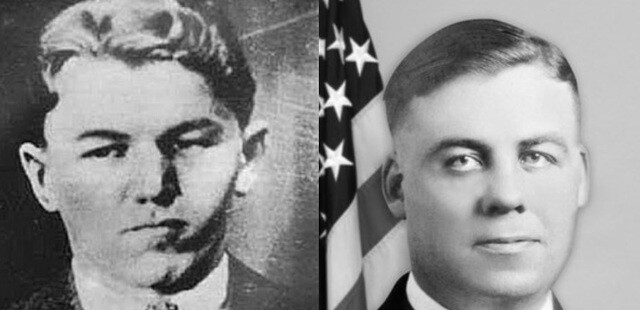
Images from fieldtripper.com and fbi.gov Left: Baby Face Nelson Right: FBI agent Sam Cowley
With a rap sheet that included apprehending the notorious gangster John Dillinger, FBI agent Sam Cowley was called on to apprehend another dangerous criminal—Baby Face Nelson.
Lester Joseph Gillis, aka Baby Face Nelson, lived a life peppered with crime even before he became a notorious bank robber and murderer—stealing tires, running stills, and bootlegging when he was just a teenager.
After Gillis murdered several men—including an FBI agent and a police officer—robbed multiple banks, and escaped prison, FBI agents Herman Edward Hollis and Sam Cowley were asked by President Hoover to find Gillis.
► You'll also like: The Latter-day Saint FBI Agent Who Took Down "Baby Face Nelson"
While driving the opposite direction on Route 14 in Fox Grove, Illinois, Cowley and Hollis happened to pass Gillis in a car with his wife and fellow crime associate John Paul Chase. Recognizing Baby Face Nelson, Hollis and Cowley immediately whipped their car around to follow Gillis.
However, both Hollis and Cowley were fatally injured when Gillis and his associate Chase initiated a shootout with an automatic rifle and Thompson machine gun, but not before the FBI agents fired a shot that hit the radiator of Gillis's car, disabling it.
Hollis passed away at the scene while Cowley passed away the next morning from bullet wounds in his abdomen.
During the shootout, Hollis fired off 10 shots while Cowley fired 50, mortally injuring Baby Face Nelson. Though Gillis escaped along with Chase and his wife, Helen Gillis, he died at 8 p.m. the night of the shootout on November 27, 1934.
Most Mormons are mild-mannered, well-behaved, law-abiding citizens who tend to get along well with their neighbors. But every once in a while, there's a renegade. You know the one: a little bit wild-eyed, ready to rumble, out to go where no Mormon has gone before. Face it: we all know one.
Well, if you think you've seen a colorful character or two in your ward, you should check out the colorful characters in this book—some Mormons, some non-Mormons who impacted Church history. These people are a whole new breed of colorful.
